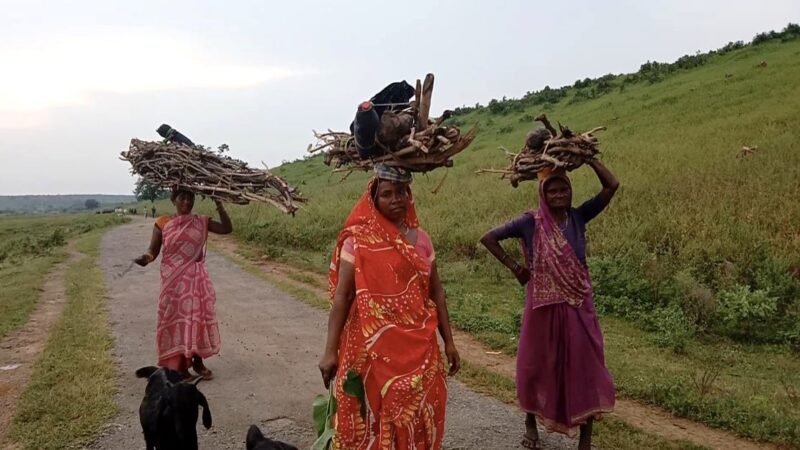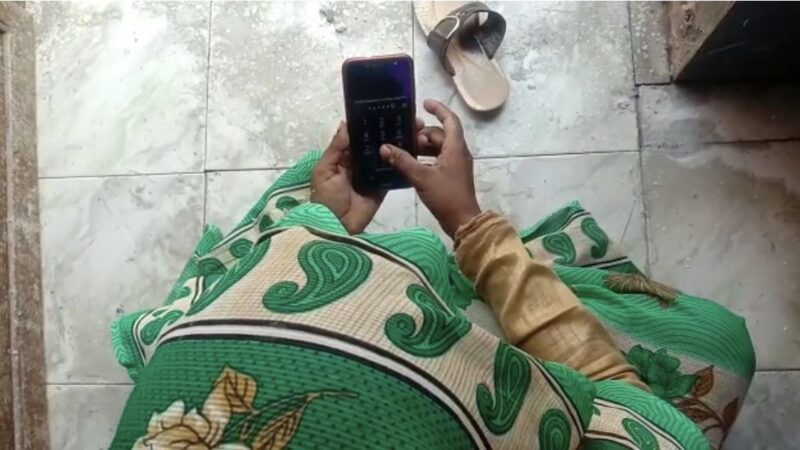
Daily updates and status reports of the Covid-19 situation had to be uploaded via an official Government app. Photo by Meera Devi for Khabar Lahariya. Used with permission.
This article was written by the Khabar Lahariya staff based on investigative reports by Chambal Media, supported by Check Global. Video reports by Meera Devi.
Digital panaceas for a still analog world has been the Indian government’s favourite way of ceding culpability for crisis situations. Fleeting and one-size-fit-all policies and technologies are put in place without considering existing inequalities and the unintended impact on different communities.
The COVID-19 pandemic brought about a greater reliance on digital technologies and an increased emphasis on digitisation in India. Several basic services moved online. The urban-rural divide in digital adoption is stark and obvious, but it is worse in rural areas, especially for rural women, who are often marginalized within mainstream discourses on law, policy, and the media.

Manikpur, UP: Kol adivasis travel to nearby cities via train to sell firewood, a primary source of their livelihood, which took a major hit during the nationwide lockdown. Photo by Meera Devi for Khabar Lahariya. Used with permission.
Digital gender gap: Online ticketing when mobile phones are a luxury and railway stations are far off
The local population of over 40,000 Kol Adivasis of Manikpur block in Chitrakoot district of Bundelkhand primarily depend for their livelihoods on gathering firewood from the forests and selling it in nearby urban centres. Kol women carry heavy bundles of chopped firewood on trains that are the lifeline of this trade.
The wood is sold by the women in the nearby markets of Allahabad, Banda, Karwi, and Atarra, all towns and commercial centres in Uttar Pradesh.
After the COVID-19 pandemic hit India in March 2020, train services came to a halt, disrupting thousands of livelihoods and the flow of income, food, medicines, and other essential supplies to the most vulnerable populations of the region. In spite of the trains resuming their services in November 2020, the situation on the ground did not improve for the Kol women. In an attempt to jumpstart activities, the government mandated that all train bookings be conducted only online.

When trains resumed in November, Kol adivasis found it difficult to adapt to the online booking system without smartphones and the digital know-how to navigate the system. Photo by Meera Devi for Khabar Lahariya. Used with permission.
But this effort renders invisible the plight of the Kol community, for whom the online booking portal is as inaccessible as it is nightmarish. Most people from the community did not have a smartphone to book tickets online, and, if they did have a phone, they lacked the technological know-how. Data shows that less than 3 in 10 women in rural India have ever used the internet in their lives. Alternatively, if they wanted to purchase a physical ticket from the counter, they had to travel first from their homes to Bargarh or Manikpur station by public transport and travel to these stations cost them INR 60 (USD 0.80) and at least 2–3 hours of travel time.
Meera Devi from Khabar Lahriya, an independent feminist grassroots news network, reports that the advent of the online booking system has severely disrupted the daily schedule of Koi Adivasis like Rajkumari. She must walk 10 km in one direction to attempt to book a ticket, failing which she must resume the long walk home, only to repeat the whole process again the next day.
“The travelling ticket examiner, on each train, says that I am stuck in my old ways, but what am I supposed to do when I don’t have a phone? If we aren't able to sell the wood, we sit hungry,” laments Bhondi, a woodcutter from Rampuria village in the same area.
The Kol women woodcutters of Manikpur get INR 120–150 (USD 1.6–2.0) per bundle of wood, each of which weighs around 40–45 kg. Their labour is severely undervalued and ends up costing them more than it's worth, especially when aggravated by their additional tussles with the new online ticketing system.

Since the procurement of smartphones was delayed due to the pandemic, ASHA workers without one had to borrow phones from their family members in order to complete their daily tasks. Photo by Meera Devi for Khabar Lahariya. Used with permission.
Digital health agents, without the digital technology
The local ASHA (Accredited Social Health Activist) and Anganwadi workers of Banda district in Bundelkhand are grappling with how fast their own jobs are evolving in the government’s push for Digital India. ASHA and Anganwadi workers are the backbone of India’s rural health and care services and the primary points of contact for public health concerns within communities. This voluntary workforce of poorly paid, semi-literate women is India’s first line of defense against any local health crisis. In a context where the rural women’s workforce in India is shrinking from the impact of COVID, it seems counterintuitive for the state to push for alienating technologies that further disenfranchise these women. Within Banda district alone, there are over 1,705 Anganwadi centres and over 1,400 ASHA workers. With the COVID-19 surge across the country, ASHA and Anganwadi employees saw an increase in the demands of their job as last-mile healthcare providers and caregivers.
In another Khabar Lahariya report by Meera Devi, Renu Maurya tells us about her life as an Anganwadi worker during the pandemic:
We would start early in the morning, do house calls. They were giving us a daily target of twenty house calls. We would note down the details and bring back the data to the office. Apart from paying for the travel, I wasn't getting anything else. They didn’t care whether I ate or not.
In this case house calls refer to telephonic conversations with local people in villages for COVID-19 inspection, to check for symptoms and if they needed to be tested.
Gudiya, an ASHA worker in Banda tells us that they were called by authorities for briefings on how to manage quarantines in the village but were not given a mobile phone though it had become essential to the work of these centres during the pandemic. “They told me to manage on my own. I would use my husband or my son’s phone.”
“We have to send daily lists, send reports of any deliveries, and any and every kind of paperwork needs to be sent to our superiors using our phones. I borrow someone else’s phone. I have no other option, what can I do?” says Maya Devi, an ASHA worker from Chitrakoot.

Apart from an increase in workload, ASHA and Anganwadi workers had to face a lot of issues around limited data and connectivity. Photo by Meera Devi for Khabar Lahariya. Used with permission.
While some centres provided their employees with smartphones, even that process was not hassle-free. Renu Maurya says, “I pay for the phone from my own pocket. Now the data has become so expensive that I have to pay at least INR 200 (USD 2.66) for 28 days.”
Rukmini Devi, an Anganwadi worker, says: “For INR 5000 (USD 67) I can either buy a smartphone or feed my kids. There’s only so much I can do with INR 5000.”
Rukmini Devi’s choice between her children and a smartphone is not metaphorical: women are often forced to make the literal choice between diverting resources towards their own employment opportunities, or their families. Predictably, they are often forced to sacrifice their autonomy in favour of the household. This choice spells the end of any sort of financial independence for many women.
In several cases, these barriers to entry — albeit ‘digital’ — can mean the end of employment, education, and freedom for the already alienated women of rural India. While hurtling towards an increasingly digitised present, it's critical that we do not lose sight of those for whom both the past and future appear precarious.







